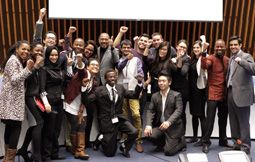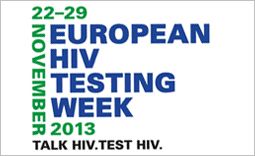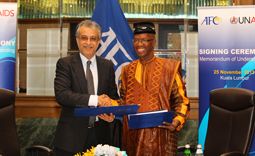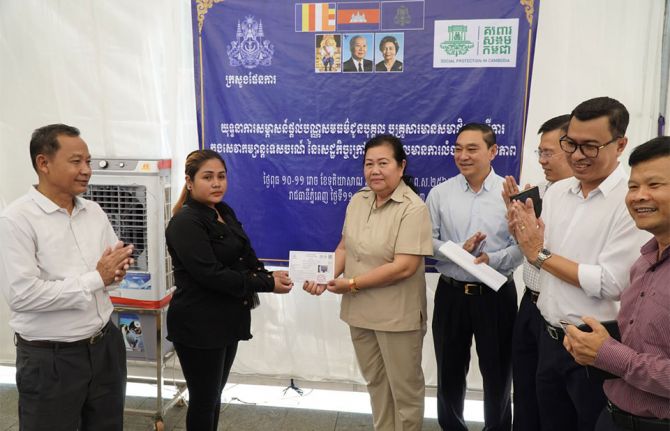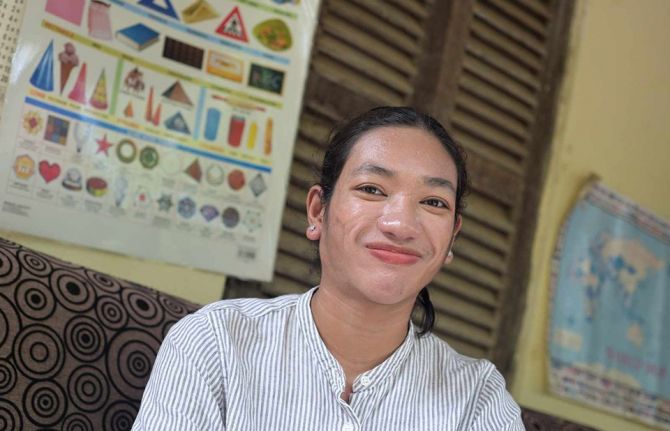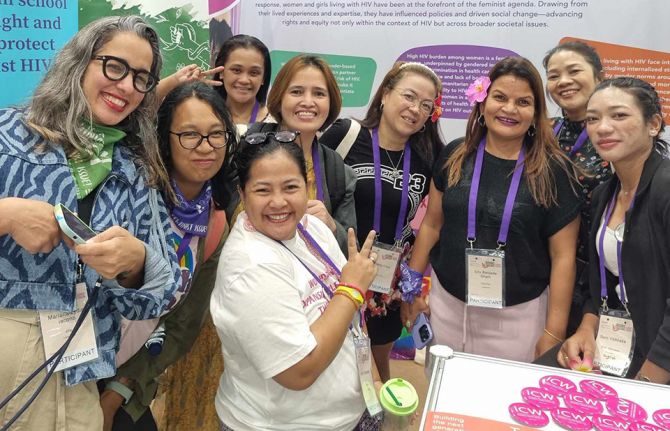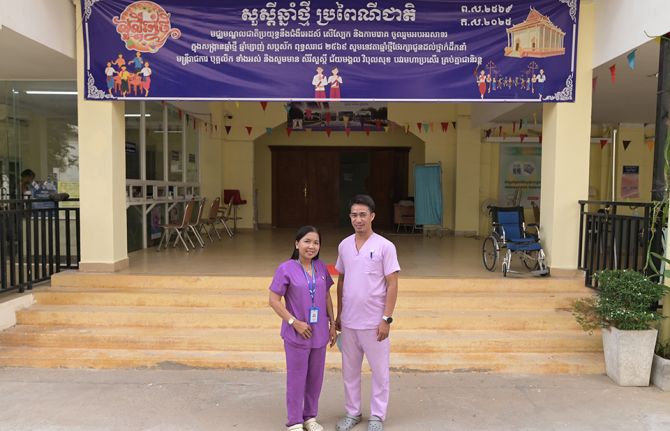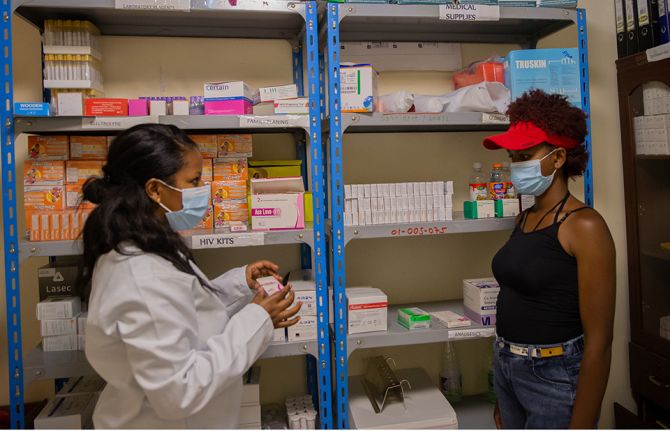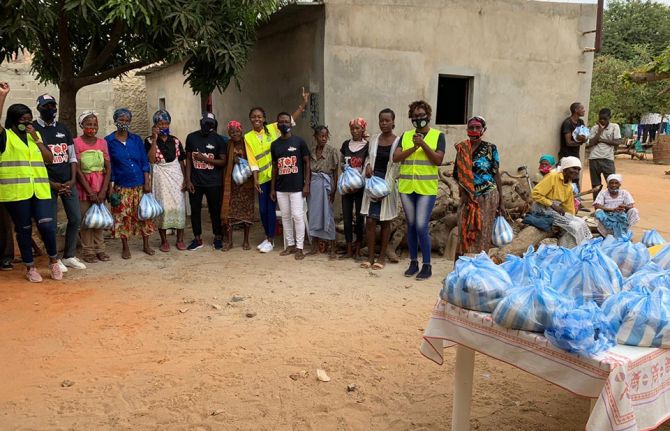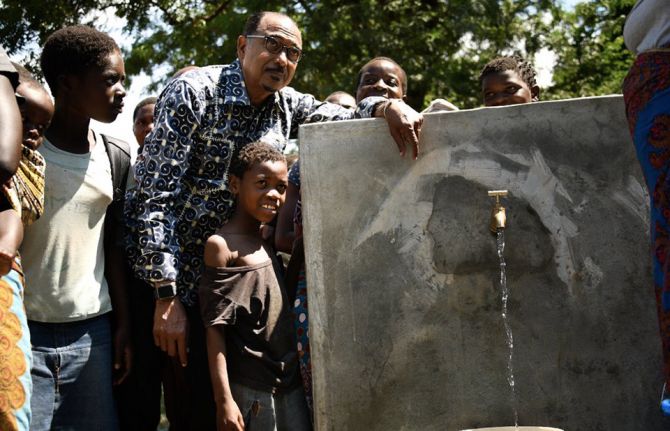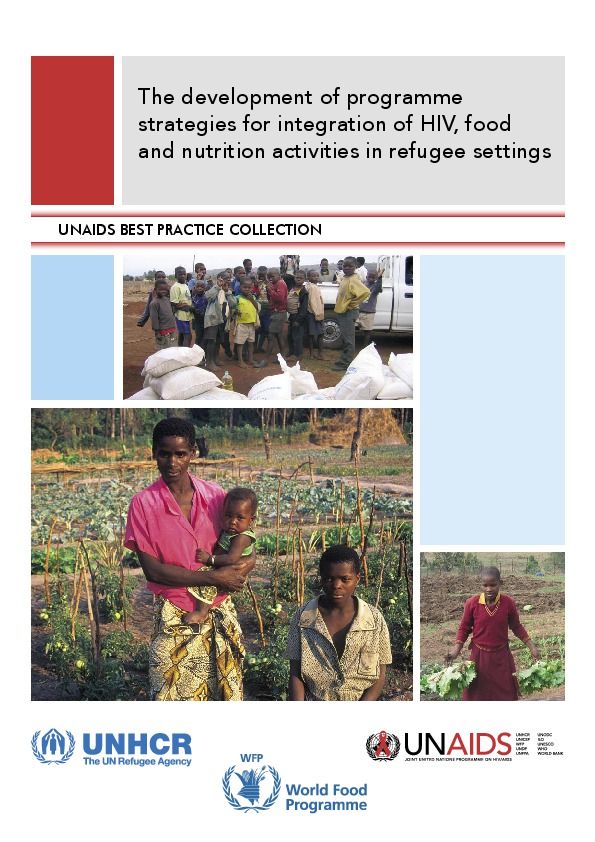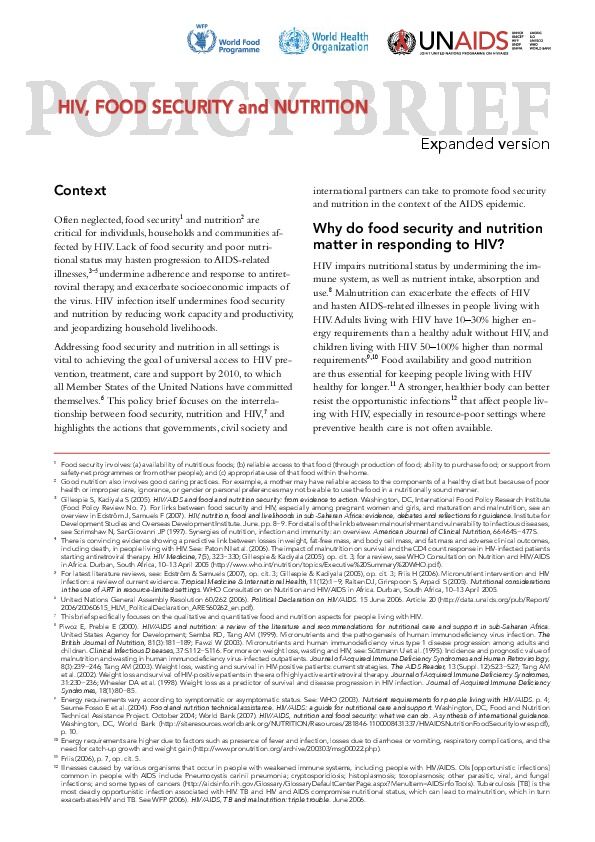
Feature Story
Joint action for results: UNAIDS outcome framework, 2009 – 2011
22 April 2009
22 April 2009 22 April 2009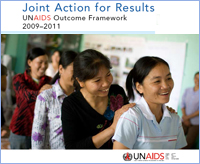
The HIV organizational landscape has evolved and grown more complex over the past decade. UNAIDS, donors and civil society, including networks of people living with HIV, have rightly demanded greater clarity on the relationships between needs, financing, activities and outcomes. Also demanded is greater specificity about the role of UNAIDS and the Secretariat within the wider constellation of actors.
This Outcome Framework, which builds upon the UNAIDS Strategic Framework (2007–2011), will guide future investment and hold the Secretariat and the Cosponsors accountable for making the resources of the UN work for results in countries. It affirms the UNAIDS Secretariat and Cosponsors to leverage our respective organizational mandates and resources to work collectively to deliver results.
Joint action for results: UNAIDS outcome framework, 2009 – 2011 (pdf, 388 Kb)
Joint action for results: UNAIDS outcome framewor
Cosponsors:
Office of the United Nations High Commissioner for Refugees (UNHCR)
United Nations Children's Fund (UNICEF)
World Food Programme (WFP)
United Nations Development Programme (UNDP)
United Nations Population Fund (UNFPA)
United Nations Office on Drugs and Crime (UNODC)
International Labour Organization (ILO)
United Nations Educational, Scientific and Cultural Organization (UNESCO)
World Health Organization (WHO)
World Bank
Publications:
Joint action for results: UNAIDS outcome framework, 2009 – 2011 (pdf, 388 Kb)
Related

Feature Story
UNAIDS Committee of Cosponsoring Organizations meet
06 April 2009
06 April 2009 06 April 2009
(from left): Joy Phumaphi, Vice President and Head of the Human Development Network, World Bank; Arnauld Akodjenou, Director, Division of Operational Services, UNHCR; Josette Sheeran, Executive Director, WFP; Anarfi Asamoa-Baah, Deputy Director General, WHO; Assane Diop, Executive Director, Social Protection Sector, ILO; Koichiro Matsuura, Director General, UNESCO; Ad Melkert, Administrator ad-interim, UNDP; Ann M. Veneman, Executive Director, UNICEF; Michel Sidibé, Executive Director, UNAIDS; Thoraya Ahmed Obaid, Executive Director, UNFPA; Antonio Maria Costa, Executive Director, UNODC. Paris, 3 April 2009,
The Joint United Nations Programme on HIV/AIDS (UNAIDS) brings together the efforts and resources of ten UN system organizations in the AIDS response. The UNAIDS Committee of Cosponsoring Organizations (CCO) serves as the forum for these Cosponsors to meet on a regular basis to consider matters of major importance to UNAIDS, and to provide input from the Cosponsoring organizations into the policies and strategies of UNAIDS.
On 3 April 2009, the CCO held their first meeting since the appointment of UNAIDS Executive Director Michel Sidibé.
The CCO expressed their full support for “universal access” which Mr Sidibé has outlined as the top priority for UNAIDS as well as the other priority areas of focus which will be set out in the new UNAIDS outcome framework currently being finalized with Cosponsors.
The meeting provided an excellent opportunity to share ideas on supporting countries in achieving their universal access goals. The need for UNAIDS to advocate for an evidence informed AIDS response that is grounded in human rights was accepted by all. Equally important was the need for accountability and results.
The CCO also endorsed the general directions of the 2010-2011 Unified Budget and Workplan including the key priorities and the allocation of resources between the Cosponsors, the Secretariat and Interagency activities. The Secretariat will now work with the Global Coordinators of the Cosponsors to finalize the UBW for the June 2009 meeting of the Programme Coordinating Board.
UNAIDS Committee of Cosponsoring Organizations (CCO)
The CCO comprises representatives from the ten UNAIDS Cosponsors and the UNAIDS Secretariat. It meets twice a year and each Cosponsor rotates as chair of the committee annually, on 1 July.
Right Hand Side
Cosponsors:
Office of the United Nations High Commissioner for Refugees (UNHCR)
United Nations Children's Fund (UNICEF)
World Food Programme (WFP)
United Nations Development Programme (UNDP)
United Nations Population Fund (UNFPA)
United Nations Office on Drugs and Crime (UNODC)
International Labour Organization (ILO)
United Nations Educational, Scientific and Cultural Organization (UNESCO)
World Health Organization (WHO)
World Bank
Related
 Keeping up the momentum in the global AIDS response
Keeping up the momentum in the global AIDS response

24 April 2019
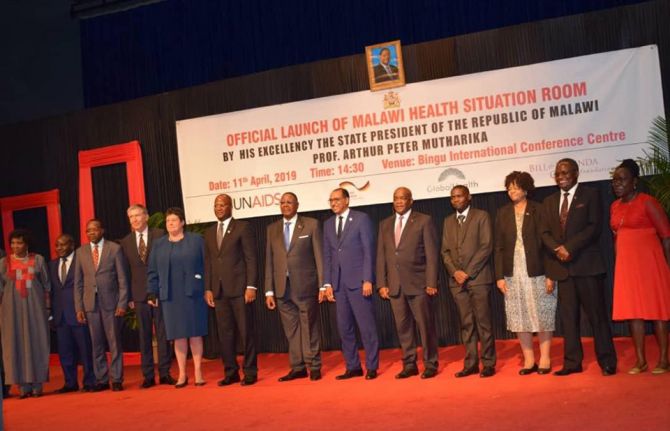 Malawi launches its health situation room
Malawi launches its health situation room

12 April 2019
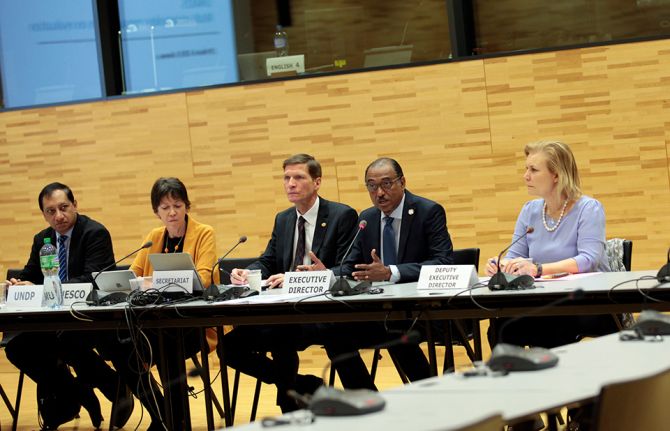 Learning lessons on evaluation
Learning lessons on evaluation

02 April 2019

Feature Story
HIV and high food prices
01 April 2009
01 April 2009 01 April 2009Leaders of the Group of Twenty (G-20) countries are gathering in London for a summit to identify steps that can help restore global economic growth.
The current crisis in financial markets and the world economy strains both governments’ global development commitments and national resources. Households already most vulnerable to poverty, risk further impoverishment.
This is the first in a series of articles on how poverty impacts people already affected by HIV and how investment in sustainable financing is critical for AIDS and development responses around the world. Access to affordable food is vital for workers living with HIV, explains Robin Landis, HIV Policy Officer with the World Food Programme.
HIV and high food prices
This article appears in the current edition of AGENDA magazine, published by the International Transport Workers’ Federation.
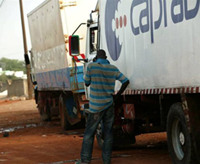
A truck driver in Mali. Credit: UNAIDS/P. Virot
Although antiretroviral drugs (ARVs) are free in Mozambique and access to them is relatively easy, Ana Costa abandoned her treatment some months ago after two years of suffering from nausea and weakness as a result of taking the powerful drugs on an empty stomach. Ana is not alone in facing a gut-wrenching dilemma – her health is so fragile that she is unable to work yet if she does not work she cannot afford to buy food. Although she knows that her health depends on the ARVs, she feels that she has no choice but to abandon the treatment since she cannot eat regularly.
It may not be the first thing one thinks of when the topic of HIV comes up, but food and more precisely, good nutritious food, is often the most pressing need for people living with HIV and their families. Malnutrition and HIV are a deadly combination: HIV attacks the immune system and deteriorates the nutritional status one needs to fend off infections while poor nutritional status hastens the onset of AIDS-related illnesses.
Hunger plays a commanding role in spreading the virus, as it drives people to desperate measures that put their lives and others at risk just to put food on the table.
Hunger plays a commanding role in spreading the virus, as it drives people to desperate measures that put their lives and others at risk just to put food on the table. In parts of southern Africa it is not uncommon for women to be forced into exchanging sex for a meal, a ride to the clinic or school fees for their children. The immediate need to make ends meet can cloud the decisions that impact their long-term future.
The importance of good nutrition for healthy living is well established and it is equally well known that mobile transport workers have less than optimum nutrition due to the demands of the job. It is common for transporters to eat irregular meals of poor nutritional quality for extended periods while they are working. Poor nutrition has a direct impact on the body’s ability to fight off infection and remain strong and productive on the job.
High food prices make a bad situation worse
The impact of climate change and the loss of agricultural land due to biofuel production have both contributed to inflated food and oil prices, which in turn have seriously impacted food production and distribution costs. The current crisis is affecting people around the world, especially those living in developing countries – people in rural areas who depend on agriculture for their livelihood and urban dwellers who must purchase everything they eat.
The sharp rise in global food prices, especially since early 2008, has already resulted in dietary changes that severely affect the health and nutritional status of millions of people. To cope with this crisis many families will avoid more expensive foods that also happen to be the most nutritious (meat, poultry, eggs and fish, fruit and vegetables) and reduce the size and frequency of meals.
Such dramatic changes in food consumption can have dire nutritional and health consequences for the most vulnerable in society: young children, pregnant and lactating women and the chronically ill, especially those with TB, HIV and AIDS. For poor, HIV-affected households the shift to less nutritional foods may happen sooner as a result of the increased burden of care. When the quality of food goes down so does the presence of micronutrients, which in turn can trigger illness and infections, making the already sick even sicker. It can also lead to drug resistance, treatment failure and even new strains of virus as HIV-positive people begin to skip doses or abandon treatment altogether because they have no food to accompany their medication.
The same goes for people on TB treatment. They are at increased risk of dropping out of treatment programmes as they divert money that would be spent on transportation or other needs in favour of buying food. Interrupted TB treatment can result in the proliferation of multi-drug resistant and extremely drug resistant strains of TB – both of which jeopardise the wider public health.
What does this mean for transport workers?
Mobility is a driver of the HIV epidemic. But there are other lesser-known links between the transport sector, HIV incidence and high food prices. In southern Africa, where HIV prevalence is the highest, AIDS has affected transport companies to the point that, even before we see the full impact of this current crisis, there are not enough truck drivers to meet demand. For instance, during the food crisis of 2003-05, the World Food Programme (WFP) contracted over 30 per cent of the total transport business in the region and found it difficult to hire enough vehicles and drivers to deliver food assistance quickly and efficiently. Approximately 80 per cent of WFP’s transport needs are hired locally. The shortage of skilled drivers results in higher transport costs and subsequent higher prices for food and other goods.
WFP is proud to be a core partner, along with TNT, ITF and UNAIDS, of the North Star Foundation, a public-private partnership to improve the health and wellbeing of mobile transport workers and reduce the number of new HIV infections by establishing networks of roadside ‘wellness centres’.
Food aid for HIV
WFP estimates that 22 of the 30 countries in greatest need of food assistance are in sub-Saharan Africa, home to two thirds of the 33 million people living with HIV. In the past, only the poorest 10 per cent of the population has generally needed assistance, but as prices increase more households will slide into poverty and be forced to find ways to cope. Women, who already represent 70 per cent of the world’s poor, will suffer the most as more will be pushed into transactional sex to survive, which increases the risk of new infections.
Providing HIV positive people with a way out of poverty can help ensure that they have nutritious food on the table, an education for their children and access to medical care and treatment. With food prices projected to stay high, incorporating a nutritious food package into HIV treatment programmes can maximise the benefits of the medicine and guard against treatment failure. For as little as US$0.70 an adult living with HIV can receive a nutritious ration of corn-soya blend, maize meal and beans. In addition to food aid, programmes that link households to livelihood support programmes are needed. If markets are able to provide a nutritious diet, cash transfers or micro-financing may be more appropriate than food packages.
What can workers’ unions do?
- Advocate national policies that prioritise HIV and TB treatment programmes and incorporate nutritional packages as part of these programmes.
- Use national and regional meetings to inform and educate union members on issues of food and nutrition insecurity in the context of HIV and AIDS.
- Be the eyes and ears of the community: let the ministries of health and national AIDS committees know when communities are struggling with the decision to either spend on health care or buy food.
- Support workplace HIV programmes and make sure that they address the importance of good nutrition for people living with HIV. Work with the programme manager to offer advice and assistance to HIV-positive employees who may be having difficulty keeping a healthy diet.
- Use union networks to help distribute agricultural inputs like fertilizer, seeds and tools and help link communities to markets.
- Lobby employers to ensure that nutrition information and access to nutritious food is available for mobile transport workers while on the job.
Robin Landis is a Policy Officer in the Policy, Planning and Strategy Division of the WFP in Rome. She is also on the Management Team of the North Star Foundation, a public-private partnership to reduce the impact of HIV in the transport sector.
Right Side Content
Cosponsors:
Partners:
Feature stories:
Minister of Foreign Affairs of the Russian Federation discusses financial crisis with UN agencies (09 March 2009)
As global economy slows International Health Partners push for faster health progress (12 February 2009)
The impact of nutrition and HIV: World Food Programme (26 November 2008)
External links:
Agenda Magazine, Issue 3, 2009 (pdf, 1.49 Mb)
Related

Feature Story
Highlighting sexual violence on International Women’s Day
05 March 2009
05 March 2009 05 March 2009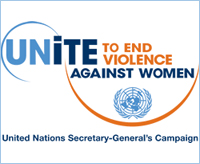
"Women and men: United to end violence against women" is the theme of this year’s International Women's Day which is observed at the United Nations on 5 March 2009 and celebrated internationally on 8 March.
Sexual violence, and the threat of violence, increases women’s vulnerability to HIV and in certain parts of the world is being used as a tactic of war.
UN Secretary-General Ban Ki-moon highlights this in his message marking International Women’s Day: “Violence against women is also linked to the spread of HIV/AIDS. In some countries, as many as one in three women will be beaten, coerced into sex or otherwise abused in her lifetime. Women and girls are also systematically and deliberately subject to rape and sexual violence in war.”
UNAIDS Executive Director Michel Sidibé is also unequivocal on the need to end this violence in his statement: “Violence, including rape and sexual abuse against women and girls should not be tolerated in any circumstances, be it in conflict or war or at home in our own communities.”
Sexual violence in conflict
Sexual violence in conflict has not been a high priority for security institutions and is often overlooked due to stigma and under-reporting. However, the trauma and terror of rape can wound as deeply as bullets and in areas with high HIV prevalence, women are also at risk of being infected with HIV.
Leo Kenny, Team Leader of UNAIDS Security and Humanitarian Response is convinced of the pressing need to address the issue sexual violence among the uniformed services: “While soldiers and uniformed service personnel have been perpetuators of violence against women, they have also been part of the solution and are potential key agents of change if the right programmes are put in place.”
“Educating and involving peacekeepers in addressing sexual violence is important as soldiers have influence among their peers both within the service and the wider community. By changing their perceptions and behaviours it can positively impact the larger population,” Mr Kenny added.
"Violence, including rape and sexual abuse against women and girls should not be tolerated in any circumstances, be it in conflict or war or at home in our own communities."
UNAIDS Executive Director Michel Sidibé
The women who survive sexual violence need access to comprehensive health and counselling services and, where necessary, HIV prevention, treatment, care and support. However the context of civil unrest can result in barriers to universal access to these services.
There is also a need for the millions of uniformed service personnel worldwide to be integrally considered in the scale up towards universal access to HIV prevention, treatment, care and support.
UN Action against Sexual Violence in Conflict
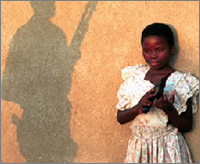 "Women and men: United to end violence against women" is the theme of this year’s International Women's Day which is observed at the United Nations on 5 March 2009 and celebrated internationally on 8 March. Credit: UNAIDS
"Women and men: United to end violence against women" is the theme of this year’s International Women's Day which is observed at the United Nations on 5 March 2009 and celebrated internationally on 8 March. Credit: UNAIDSTwo years ago today, UN bodies came together to form a joint initiative, “UN Action against Sexual Violence in Conflict.” The partnership now stands at twelve UN entities which seek to draw attention to the issue of sexual violence in conflict and the need to do more, to improve the quality of programming to address sexual violence, to increase the coordination of efforts for comprehensive prevention and response services, and to improve accountability as well as to respond effectively to the needs of survivors.
The UN Action initiative is designed to create greater awareness of these abuses and, ultimately, end sexual violence to make the world safer for women and girls.
Three main pillars
The first aspect of this initiative, country level action, involves country level support and efforts to build capacity and train advisers in gender-based violence programming and coordination, as well as support for joint UN programming in selected countries.
Second, “advocating for action”, raises public awareness and generates political will to address sexual violence as part of the broader campaign to “Stop rape now.” The third aspect is the creation of a knowledge hub on sexual violence in conflict and effective responses.
Stop rape now
Rape has deep roots in a historical absence of accountability and UN Action has helped catalyze a paradigm shift: insisting that sexual violence is recognized as a security threat that demands a security response, rather than simply an inevitable byproduct of war.
International Women’s Day
In 1977 the UN General Assembly adopted a resolution inviting Member States to proclaim a United Nations Day for Women's Rights and International Peace—International Women's Day—in recognition of the fact that securing peace and social progress and the full enjoyment of human rights and fundamental freedoms require the active participation, equality and development of women; and to acknowledge the contribution of women to the strengthening of international peace and security.
For women around the world, the symbolism of International Women's Day has a wider meaning: it’s an occasion to celebrate how far women have come in their struggle for equality and an opportunity to unite, network and mobilize for meaningful change.
Highlighting sexual violence on International Women’s Day
International Women's Day 2009 statements:
Statement by UN Secretary-General Ban Ki-moon (pdf, 25 kb)
Statement by UNAIDS Executive Director Michel Sidibé
Statement by WHO Director-General Dr Margaret Chan
Statement by UNESCO Director-General Koïchiro Matsuura (pdf, 61 Kb)
Statement by UNFPA Executive Director, Thoraya Ahmed Obaid
Statement by UNICEF Executive Director Ann M. Veneman
More from UNAIDS Cosponsors on International Women's Day:
Interview with WFP Head of Gender Unit Isatou Jallow
UNDP's special on the occasion of the International Women's Day 2009
UNODC's special on the occasion of the International Women's Day 2009
ILO celebration for International Women's Day 2009
World Bank's special on the occasion of the International Women's Day 2009
Cosponsors:
UNDP - UN Development Programme
UNFPA - United Nations Population Fund
UNHCR - UN High Commissioner for Refugees
UNICEF - United Nations Children Fund
WFP - World Food Programme
WHO – World Health Organization
Partners:
DPA - Department of Political Affairs
DPKO - Peacekeeping Best Practices
OCHA - Coordination of Humanitarian Affairs
OHCHR - United Nations Human Rights
UNIFEM - UN Development Fund for Woman
Feature stories:
HIV prevention and the uniformed services in CIS (08 October 2008)
Contact:
For more information on this campaign contact by email: anna.tarant@unifem.org
External links:

Feature Story
The impact of nutrition and HIV: World Food Programme
26 November 2008
26 November 2008 26 November 2008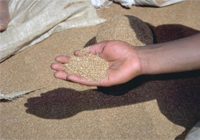
Credit: UNAIDS/ L. Alyanak
The World Food Programme (WFP) is the lead UN agency providing emergency food assistance and the world's largest humanitarian agency. As a cosponsor of UNAIDS it also plays a unique and significant role in the global AIDS response. In 2007, WFP reached 1.3 million people affected by HIV in 20 of the 25 highest HIV prevalence countries.
For a person living with HIV to respond well to antiretroviral treatment, access to adequate food is essential. WFP was one of the first agencies to provide food to complement the expansion of people’s access to HIV treatment. Last year, WFP supported treatment programmes in 16 African countries, providing food support to over 332,000 beneficiaries during the critical early stages of treatment.
High Food Prices
With high food prices jeopardizing household food security of some of the most vulnerable people in the world, the importance of WFP’s nutritional response for people living with HIV and their families has never been more urgent. A recent pilot study from Zambia showed that food supplementation improved treatment adherence and there is growing evidence from various countries that health clinic attendance has decreased as food prices increase.
UNAIDS and WFP
WFP’s lead role in dietary and nutritional support in the UNAIDS Division of Labour (DoL) involve leadership in the delivery of food assistance and nutritional support and in enhancing national actions through advocacy, guidance and technical support.
WFP is central to efforts to scale up HIV services for populations of humanitarian concern, and it has been integrating HIV treatment and support with inter-agency emergency preparedness, response and recovery activities in Latin America, the Caribbean and Africa. Many different food products are being developed and tested to improve the health and well-being of people on HIV treatment. WFP’s is involved in providing support to scientific studies on the efficacy of specially formulated food products for the nutritional needs of people living with HIV.
Unique contribution at national level
WFP works through national governments and local partners to provide food and nutritional assistance to food insecure people living with HIV and their families. This can make a big difference to a household when the main breadwinner is too ill to work. It also provides in-school meals for orphans and other children affected by HIV. It also provides technical assistance to national governments to ensure that people living with HIV have access to appropriate nutritional food to accompany their treatment and the Programme ensures that people living with HIV link to community support mechanisms to help ensure longer-term livelihood survival.
WFP and “responsible transport”
WFP works with private sector companies that employ thousands of truck drivers to transport food and goods to people in need. However throughout Southern Africa, high prevalence rates of HIV are found along the commercial transport corridors and the World Food Programme, taking its corporate responsibility seriously, wishes to minimize the risks of HIV infection.
In the past year, WFP has improved its HIV prevention and health services for transport workers under its commitment to support “responsible transport”. The project helps to protect the health and well-being of transporters and the local communities they come in contact with along the way. The wellness centre pilot project in Malawi, supported by WFP and TNT, has grown into an independent non-profit alliance called North Star Foundation (NSF) that includes UNAIDS and the International Transport Workers Federation as partners. Five NSF wellness centres are now operating – two in Malawi, one in Namibia, one in Swaziland and one in Zambia; two more in Zimbabwe will open in 2008. NSF will work with Family Health International to set up 23 wellness centres in eight east African countries over the next three years.
Country offices in Benin, Chad, the Democratic Republic of Congo, Ethiopia, The Gambia, Kenya and Niger have worked with United Nations and NGO partners to provide HIV training, improved access to health services and enhanced workplace HIV policies for transport workers.
New Guidance Materials Produced by WFP
In response to requests from country offices for detailed guidance on HIV programming, several guidance tools have recently produced. These are linked on right of the page under “Tools”.
Future Directions
WFP can help advance the debate on and deepen understanding of the nutritional needs of people living with HIV and their family members, working together with the cosponsors by advocating with major funding mechanisms such as PEPFAR and the Global Fund. WFP can help ensure that national and community-level HIV and AIDS programmes, especially treatment programmes, include gender-responsive nutritional components. WFP can also support and promote scientific studies that look at the efficacy of specially formulated foods for the nutritional needs of PLHIV.
The impact of nutrition and HIV: World Food Progr
Cosponsors:
Press centre:
WFP becomes ninth Cosponsor of UNAIDS (16 October 2003)
Feature stories:
New UNAIDS policy on HIV, food security and nutrition (21 May 2008)
AIDS, nutrition and food security (28 November 2007)
External links:
North Star Foundation
International Transport Workers' Federation
Tools:
Food Assistance Programming in the Context of HIV (WFP, 2007)
Food Assistance in the Context of HIV: Ration Design Guide (WFP, 2008)
Publications:
UNAIDS/WFP/WHO Policy Brief – HIV, food security and nutrition (pdf, 247 Kb)
Hunger, health and HIV/AIDS: a critical connection
Full matrix of the UNAIDS Division of Labour (gif, 141 Kb)
UNAIDS Technical Support Division of Labour: Summary & Rationale (pdf, 403 Kb)
Related

Feature Story
New UNAIDS policy on HIV, food security and nutrition
21 May 2008
21 May 2008 21 May 2008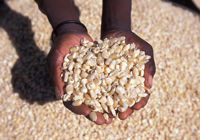
In many parts of the world, lack of food
security and poor nutrition are worsening
the effects of the HIV epidemic.
Photo credit: UNAIDS/M.Jensen
In many parts of the world, lack of food security and poor nutrition are worsening the effects of the HIV epidemic. Food insecurity and poor nutrition can hasten the progression of AIDS related illnesses, while the virus itself reduces the capacity of people living with HIV to work to provide food for themselves and their families.
For this reason UNAIDS, in collaboration the World Food Programme (WFP) and the World Health Organization (WHO), has developed a policy brief on HIV, food security and nutrition. This policy provides guidance for governments, civil society and other partners on how to address food and nutrition concerns in the context of HIV, keeping in mind the commitment made by all UN member states through the Millennium Development Goals both to reduce chronic hunger and halt and reverse the spread of HIV by 2015.
Food Security, Nutrition and HIV vulnerability
Lack of food security constrains people’s choices in employment and education and can lead women, for example, to engage in behaviours which can increase HIV risk such as exchanging sex for food or money. HIV positive mothers also need access to clean water and breast milk substitutes if they are to reduce the likelihood of transmitting HIV to their children.
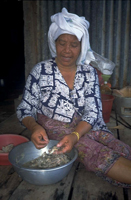
Proper nutrition is critical to
realizing the full benefits of
antiretroviral therapy.
Photo credit:
UNAIDS/L.Alyanak
Treatment
Proper nutrition is critical to realizing the full benefits of antiretroviral therapy (ART). ART itself may increase appetite and it is possible to reduce side effects and thus help people with HIV to stay on treatment if medicines are taken with food. “For two years I have been running HIV and nutrition interventions and have witnessed first hand the positive effect of nutritional counselling and support on patients receiving ART,” claims Dr Praphan Phanuphak, Director of the Thai Red Cross AIDS Research Centre. “Countries (should) set aside a percentage of their ART budget for nutritional interventions, and provide patients with income to buy food for themselves and their families, in the initial phase of treatment, when they may not be strong enough to resume work,”
Impact Mitigation
HIV can reduce capacity to work and earn income for food. It can have particularly devastating consequences where agriculture is the main source of income, leading to decreased food production and hence food insecurity. In rural households coping with HIV, where agriculture is the main employer, ensuring transfer of farming knowledge between generations and instituting measures to improve agricultural productivity will go a long way to ameliorating the impact of HIV.

HIV can reduce capacity to work and earn
income for food.
Photo credit: UNAIDS/M.Jensen
More generally, for households and communities dealing with HIV, “fighting stigma and discrimination will also help people with HIV to find and maintain employment, and thus be able to meet their own nutritional requirements,” notes Dr Phanuphak.
There is a positive association between education and reduction in HIV risk. Better educated children are more likely to absorb prevention information and adopt safer behaviours. Yet households that are not food secure are often forced to take children out of school in order to work to supplement the income lost as a result of their parents’ illness and/or death.
Therefore, UNAIDS, the World Food Programme (WFP) and World Health Organization (WHO) recommend that all actors, including Governments, international agencies and civil society, support effective food security and nutrition interventions, as part of a comprehensive and multisectoral response to HIV.
New UNAIDS policy on HIV, food security and nutri
Cosponsors:
Publications:
UNAIDS Policy Brief – HIV, food security and nutrition (pdf, 244 Kb)
UNAIDS Policy Brief – HIV, food security and nutrition (expanded version) (pdf, 247 Kb)
Related

Feature Story
AIDS, nutrition and food security
29 November 2007
29 November 2007 29 November 2007In advance of World AIDS Day, UNAIDS cosponsor organizations the World Food Programme and the World Bank have released reports focusing on AIDS, nutrition, and food security.
Hunger and Health – the World Food Programme
In Rome, Italy, the World Food Programme (WFP) launched their ‘Hunger and Health’ report – the second in a series launched in 2006 with Hunger and Learning—which highlights the vital link between food assistance and effective antiretroviral treatment in developing countries. At the launch, the UN Secretary General’s Special Envoy for Africa, Elizabeth Mataka, gave a special statement, where she underlined that “ Inequitable access to food may force people to engage in risky behaviour that can lead to their being infected with HIV. And if people can’t get hold of enough food, the efficacy of anti-retroviral treatment is seriously undermined.”
Read more on WFP's publication 'Hunger and Health'
Read Elizabeth Mataka's statement
“HIV/AIDS, Nutrition and Food Security: What We Can Do’ – the World Bank
The World Bank and partners launched the ‘HIV/AIDS, Nutrition and Food Security: What We Can Do’ report— a synthesis of existing international technical guidance on AIDS, nutrition, and food security, which is a valuable contribution to efforts that support the integration of nutrition and AIDS projects and programmes.
Read more on the World Bank's publication "HIV/AIDS, Nutrition, and Food Security: What We Can Do"
Related

Press Statement
UNAIDS welcomes Ertharin Cousin as WFP Executive Director
06 April 2012 06 April 2012GENEVA, 6 April 2012—The Joint United Nations Programme on HIV/AIDS (UNAIDS) welcomes the appointment of Ms Ertharin Cousin as the Executive Director of the World Food Programme (WFP). Ms Cousin brings more than 25 years of national and international non-profit, government, and corporate leadership experience focusing on hunger, food and resilience strategies.
“I congratulate Ertharin Cousin on taking this leadership role at WFP,” said UNAIDS Executive Director Michel Sidibé. “Food security plays a critical role in reducing HIV vulnerability and uptake of antiretroviral treatment. Together, we will work to end both—AIDS and food insecurity.”
WFP is a Cosponsor of UNAIDS and leads the programme’s efforts on dietary and nutrition support in the AIDS response. WFP’s HIV programmes focus on improving HIV treatment success through food and nutrition support, as well as mitigating the effects of HIV among food-insecure individuals and households.
Press centre
Download the printable version (PDF)
Documents
The development of programme strategies for integration of HIV, food and nutrition activities in refugee settings
15 February 2007
In 2003 UNHCR, WFP, and UNICEF launched a joint effort to develop, through multi-site field research in refugee communities in Africa, a set of strategies for using food and nutrition-based interventions to support HIV transmission prevention, impact mitigation, and care, treatment, and support for people living with HIV. This important collaborative initiative grew out of the recognition that refugee settings are unique. It was recognized also that specific research is required conducted among and with refugees. This Best Practice document discusses the research process and findings of this interagency initiative.
Documents
Policy Brief - HIV, food security and nutrition (expanded version)
10 November 2008
Often neglected, food security and nutrition are critical for individuals, households and communities affected by HIV. Lack of food security and poor nutritional status may hasten progression to AIDS-related illnesses and undermine adherence and response to antiretroviral therapy. HIV infection itself undermines food security and nutrition by reducing work capacity and jeopardizing household livelihoods.

